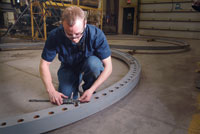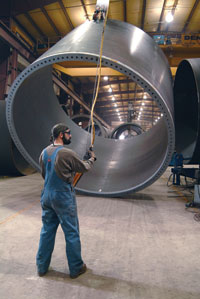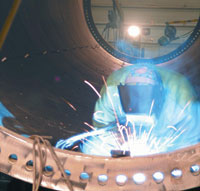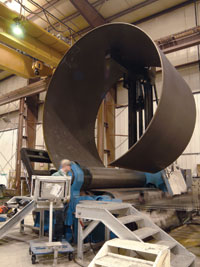 For decades, manufacturing has been one of Oklahoma’s pillars of economic stability and strength. One of the state’s largest and most important business sectors, advanced manufacturing in Oklahoma is cutting-edge, productive and efficient. As the state’s lead economic development agency, the Oklahoma Department of Commerce works to ensure the state’s manufacturing industry continues to thrive and grow.
For decades, manufacturing has been one of Oklahoma’s pillars of economic stability and strength. One of the state’s largest and most important business sectors, advanced manufacturing in Oklahoma is cutting-edge, productive and efficient. As the state’s lead economic development agency, the Oklahoma Department of Commerce works to ensure the state’s manufacturing industry continues to thrive and grow.
One of manufacturing’s great strengths is its ability to innovate and apply innovation to increase the state’s overall productivity. In Oklahoma, manufacturing jobs make up 10 percent of the overall state economy. The average wage of the advanced manufacturing worker in Oklahoma is $38,094 – more than $8,000 above the state's average personal income of $29,990. But the impact of the manufacturing industry is even more powerful when you consider the multiplier effect – all the other industries that benefit by selling services or products to the manufacturer. Manufacturers are vital to Oklahoma, especially to rural Oklahoma where the addition of one company can provide critical economic stimulus to an entire region.
From Ada to Alva, and from Tulsa to Tishomingo, in the state’s panhandle and the Ouachita Mountains, manufacturers work to strengthen the economy and help Oklahoma prosper.
Oklahoma – Attracting Manufacturing Companies
Several factors make Oklahoma attractive to manufacturing companies. Oklahoma’s central location means companies reduce logistics and transportation costs by operating equidistant between the east and west coasts, Canada and Mexico. Oklahoma is located in southern portion of the I-35 corridor, with access to 80 million people in a 500-mile radius.
 Citing easy access to national and international markets via the Port of Catoosa, DMI Industries recently expanded its wind tower manufacturing facility in Tulsa. According to DMI leadership, the company selected Tulsa because it is in the heart of the country’s fastest growing wind region and because of its close proximity to the Port of Catoosa, which gives DMI the ability to produce and deliver large, off-shore wind towers to expanding European and South American markets.
Citing easy access to national and international markets via the Port of Catoosa, DMI Industries recently expanded its wind tower manufacturing facility in Tulsa. According to DMI leadership, the company selected Tulsa because it is in the heart of the country’s fastest growing wind region and because of its close proximity to the Port of Catoosa, which gives DMI the ability to produce and deliver large, off-shore wind towers to expanding European and South American markets.
Aerospace and energy in Oklahoma provide the most immediate opportunities for manufacturers. The emerging wind industry supply chain is one of the most active areas of growth for technology-based manufacturing. Based on an analysis conducted by the National Renewable Energy Laboratory, Oklahoma is expected to generate nearly 10 percent of the nation’s wind-generated electricity by 2030. With wind energy, there is a potential to create 7,000 jobs over the next five years. Last year wind tower producer DMI announced a project expansion that will create more jobs in Tulsa. Oklahoma’s certified skills-tested workforce supports diverse, technologically advanced industries. A well-trained and highly-skilled state workforce is due to the successful collaboration between private industry, the education community and state agencies. The resurgence of the energy and aerospace industries in Oklahoma has caused a high demand for skilled workers. Propelled by a knowledge-based economy, Oklahoma’s advanced manufacturing sector needs welders as prepared to weld with computers and robots as they are with torches. Oklahoma needs engineers ready to retool their skills for its emerging wind and solar industries. The grit of yesterday’s manufacturing operations is giving way to facilities that use “clean” rooms and nanotechnology.
In Quapaw, Oklahoma, Umicore recently broke ground on a $35 million factory that will produce a small part for high efficiency solar panels used for satellites and other space applications, adding 50 more high-tech jobs when it opens in 2010. Umicore picked Quapaw over Phoenix and Albuquerque because the company knows Oklahoma’s talented workforce is prepared to succeed in this high-tech arena of solar cell development. The new factory is Umicore’s second in Quapaw and its third in Oklahoma.
Oklahoma’s Educational System Oklahoma’s world class network of research institutions, regional universities and community colleges provide Oklahomans with the skills and knowledge valued by employers in this technology-driven global economy.
Oklahoma’s world class network of research institutions, regional universities and community colleges provide Oklahomans with the skills and knowledge valued by employers in this technology-driven global economy.
To boost advanced manufacturing, Oklahoma State University in Tulsa hosts the Helmerich Advanced Technology Center that focuses on the development of the next generation of composites and materials, and especially concentrating on aerospace, the largest industry in the state. The research conducted in the center will result in commercialization of new technologies designed to help the state's economy by creating jobs and attracting companies. The 123,000-square-foot building can house up to 40 faculty and researchers and 100 graduate students. The research center contains specialized laboratories, a clean room, an imaging suite, and advanced information technology equipment.
Oklahoma’s Business Location and Job Growth Incentives
Oklahoma is nationally recognized for its outstanding business location and job growth incentives. Oklahoma’s award-winning Quality Jobs Program places the state at the forefront of locations for new or expanding businesses. This innovative program gives qualifying enrolled companies quarterly cash rebates of up to 5 percent of taxable wages for up to 10 years. Additionally, Oklahoma offers a wide range of tax credits, refunds and workforce training benefits to help companies succeed.
Beginning in January 2010, companies can apply for both Quality Jobs rebates as well as the new jobs tax credit. Additionally, the 21st Century Quality Jobs program, effective in November, expands the existing program to offer incentives for higher paying, knowledge-based jobs. Under this new legislation, companies that achieve wage and performance job creation targets are eligible to receive a quarterly cash rebate of up to 10 percent of new taxable payroll.
For example, Tiger Truck opened its new assembly plant and headquarters in Poteau, Oklahoma. Michael Ward, founder and CEO of Tiger Truck, praised Oklahoma for creating a business environment that made the decision easier. He said the state's tax incentive programs got the company to Oklahoma from Dallas. Tiger is the first truck manufacturer of Chinese heritage vehicles in the United States. According to Ward, "The forces in Oklahoma were not to be denied. They quickly mobilized to meet our needs in such a way that little time has been lost from our original aggressive schedule.”
 In a struggling national economy, the Oklahoma Fast Forward Team constantly strives to grow Oklahoma’s manufacturing sector. The Fast Forward team offers a confidential one-stop assistance program, provides customized relocation and expansion services, and acts as a liaison between the customer and the state, including Commerce, the Oklahoma Tax Commission, the Oklahoma Department of Transportation, utility companies and training and community economic development specialists.
In a struggling national economy, the Oklahoma Fast Forward Team constantly strives to grow Oklahoma’s manufacturing sector. The Fast Forward team offers a confidential one-stop assistance program, provides customized relocation and expansion services, and acts as a liaison between the customer and the state, including Commerce, the Oklahoma Tax Commission, the Oklahoma Department of Transportation, utility companies and training and community economic development specialists.
When Cal Edwards, owner of C.E. Aerospace, decided to relocate hisjet engine stand manufacturing facility from Ft. Smith, Arkansas to Roland, Oklahoma, he cited assistance from the Oklahoma Fast Forward Team and the Quality Jobs program incentive as the primary reason. C.E. Aerospace will add about 100 jobs in Oklahoma.
Oklahoma’s Economic Diversity
The 1980’s oil bust taught Oklahoma the value of economic diversity. Over the last 20 years, considerable investment has been made to grow the advanced manufacturing, bioscience and aerospace industries.
As you can see, Oklahoma continues a great tradition in advanced manufacturing excellence. Its interlocking system of innovation affects all sectors of the economy and helps maintain the state’s economic security. Even as other states nationwide experienced the economic crisis at a high level, the state continues to have a strong manufacturing sector. Oklahoma has been resilient, thanks in part to the role advanced manufacturing plays every day in the Sooner state.

